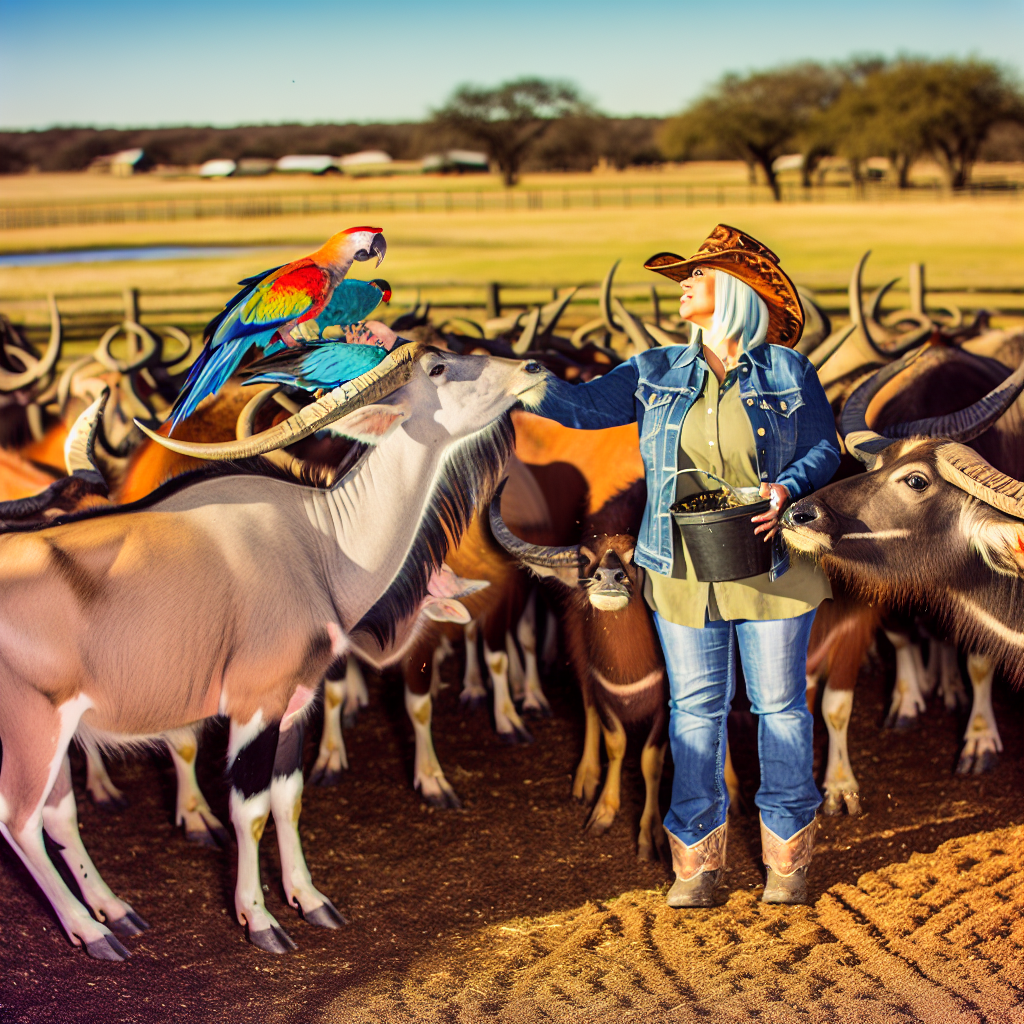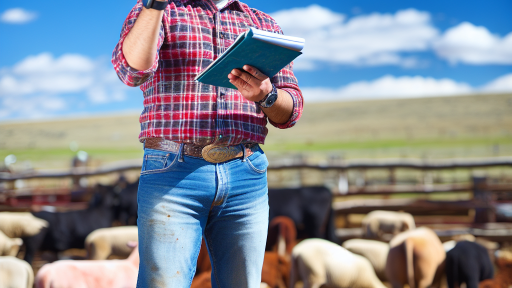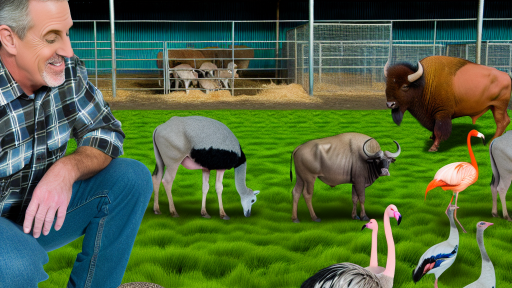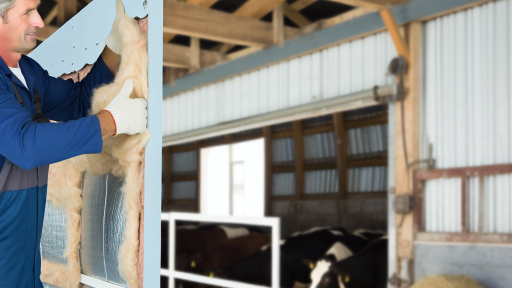Introduction to Exotic Livestock and Their Nutritional Needs
Exotic livestock includes various unusual animals raised for food, fiber, or companionship.
These animals may come from different climates and regions around the world.
Consequently, their nutritional requirements can vastly differ from traditional livestock.
Farmers should understand these unique needs to ensure their well-being.
Diverse Diet Requirements
Each species has specific dietary preferences and nutritional needs.
For example, kangaroos primarily eat grasses, while alpacas thrive on high-fiber forage.
Understanding these preferences is vital for optimal health and productivity.
Importance of Balanced Nutrition
A balanced diet supports growth, reproduction, and overall health.
Exotic livestock often require a variety of nutrients including proteins, vitamins, and minerals.
Farmers should provide access to quality forage and supplemental feed as necessary.
Moreover, adequate water intake is equally essential for maintaining hydration.
Adapting to Environmental Factors
The environment significantly influences the nutritional needs of exotic livestock.
Temperature, humidity, and altitude can all affect dietary requirements.
For instance, animals in warmer climates may require more water and electrolytes.
Adjusting the diet according to these external factors helps maintain optimal health.
Transform Your Agribusiness
Unlock your farm's potential with expert advice tailored to your needs. Get actionable steps that drive real results.
Get StartedConsulting Nutritional Experts
It is beneficial for farmers to consult with animal nutritionists.
These experts can provide tailored feeding programs based on specific livestock needs.
Additionally, ongoing education about nutrition can aid in better management practices.
Monitoring Health and Nutrition
Farmers should regularly monitor the health of their exotic livestock.
Noticing signs of nutrient deficiencies can help prevent severe health issues.
Assessing body condition and behavior aids in making necessary dietary adjustments.
Taking proactive measures ensures animals remain healthy and productive.
Understanding the Digestive Systems of Exotic Species
Overview of Digestive Anatomy
Exotic livestock have unique digestive systems.
These systems are adapted to their natural diets.
Understanding their anatomy is crucial for effective feeding strategies.
Types of Digestive Systems
Many exotic species possess ruminant digestive systems.
These systems include multiple stomach chambers.
This allows for efficient breakdown of fibrous plant material.
Examples include llamas and camels.
Some exotic species have monogastric digestive systems.
These systems consist of a single-chamber stomach.
Animals like pigs and some birds fall under this category.
They require different types of feeds compared to ruminants.
Special Adaptations
Many exotic animals have specific adaptations for food digestion.
For instance, some reptiles can absorb nutrients through their skin.
This is significant for feeding practices in captivity.
Additionally, certain fish utilize unique enzymes for digestion.
These adaptations highlight the need for specialized diets.
Importance of Fiber
Fiber plays a crucial role in the diets of many exotic livestock.
Showcase Your Farming Business
Publish your professional farming services profile on our blog for a one-time fee of $200 and reach a dedicated audience of farmers and agribusiness owners.
Publish Your ProfileIt aids in digestion and helps maintain gut health.
In ruminants, fiber stimulates chewing and saliva production.
Therefore, offering the right types of fiber is essential.
Diets should include forage and hay tailored to their needs.
Consistent Feeding Schedules
Establishing regular feeding schedules is vital for exotic species.
Consistency promotes digestive health and nutrient absorption.
Animals thrive when their routines are maintained.
Furthermore, avoiding abrupt changes in diet is critical.
This helps prevent digestive upset and health issues.
Common Feeding Strategies for Exotic Livestock
Understanding Nutritional Needs
Exotic livestock requires specialized nutrition for optimal health.
Each species has unique dietary requirements based on their habitat.
Understanding these needs is crucial for proper care and management.
Utilizing High-Quality Feed
Providing high-quality feed enhances growth and reproduction in exotic livestock.
This feed should be rich in essential nutrients like protein and minerals.
Moreover, sourcing feed from reputable suppliers ensures quality.
Implementing Balanced Diets
A balanced diet is vital for maintaining health in exotic animals.
This includes a mix of forage, grains, and protein sources.
Transitioning to new diets should occur gradually to avoid digestive issues.
Regular Monitoring and Adjustments
Regular monitoring of livestock health is essential in feeding strategies.
Weight and condition score provide insights into dietary needs.
If deficiencies are noted, adjust the diet accordingly to meet their needs.
Incorporating Natural Foraging
Encouraging natural foraging behavior can benefit exotic livestock.
This practice promotes mental stimulation and digestive health.
Furthermore, it closely mimics their natural living conditions.
Consultation with Nutritionists
Consulting with animal nutritionists brings expert insights.
They can assist in formulating diets tailored to specific species.
Professional guidance enhances feeding management practices and outcomes.
Safety and Hygiene Measures
Implementing safety measures during feeding is critical.
Hygiene practices prevent contamination and disease spread.
Additionally, regularly cleaning feeding troughs maintains a healthy environment.
Gain More Insights: Optimal Layouts For Livestock Housing Units
The Role of Forage and Pasture Management
Importance of Forage Quality
Forage quality significantly impacts the health of exotic livestock.
High-quality forage provides necessary nutrients for growth.
Moreover, it directly affects milk production in dairy species.
Additionally, quality forage contributes to overall animal well-being.
Types of Forage
Different types of forage suit various livestock species.
Grasses, legumes, and browse plants serve as essential options.
Grasses are typically lower in protein but higher in fiber.
Conversely, legumes offer more protein and essential nutrients.
Browse plants provide alternative forage sources in diverse habitats.
Showcase Your Farming Business
Publish your professional farming services profile on our blog for a one-time fee of $200 and reach a dedicated audience of farmers and agribusiness owners.
Publish Your ProfilePaddock Design and Rotation
Paddock design plays a crucial role in pasture management.
Proper paddock layouts enhance cattle grazing efficiency.
Rotational grazing prevents overgrazing and promotes pasture recovery.
Furthermore, it encourages even distribution of livestock waste.
Nutrient Management
Nutrient management is vital for optimal forage growth.
Soil testing helps identify nutrient deficiencies in pastures.
Application of fertilizers can remedy these deficiencies.
Additionally, organic amendments improve soil health over time.
Monitoring and Assessment
Regular monitoring ensures the effectiveness of forage strategies.
Evaluate forage availability and livestock health frequently.
Moreover, observe pasture conditions to adjust management practices.
Implementing these assessments fosters sustainable farming practices.
Technology in Pasture Management
Modern technology aids in efficient pasture management.
GPS and mapping tools help monitor pasture growth accurately.
Drones can capture aerial views for better planning.
Furthermore, sensors can detect moisture levels in soil.
Delve into the Subject: Preventing Diseases in Exotic Livestock
Supplementation: Vitamins and Minerals for Optimal Health
The Importance of Vitamins and Minerals
Vitamins and minerals play a crucial role in the overall health of exotic livestock.
These nutrients support growth, reproduction, and immunity.
Deficiencies can lead to various health issues and reduced productivity.
Key Vitamins for Exotic Livestock
Different vitamins serve specific functions in animal health.
Vitamin A is essential for vision and immune function.
Vitamin D aids in calcium absorption and bone health.
Vitamin E acts as an antioxidant, protecting cells from damage.
B vitamins are vital for energy metabolism and neurological health.
Essential Minerals for Optimal Function
Minerals are equally important for exotic livestock.
Calcium and phosphorus contribute to strong bones and teeth.
Magnesium aids in muscle function and energy production.
Zinc supports immune response and skin health.
Copper is crucial for iron metabolism and cardiovascular health.
Supplementation Sources
Farmers can supplement vitamins and minerals through various sources.
Commercial feeds often contain formulated vitamins and minerals.
Mineral blocks provide a convenient way for livestock to obtain essential nutrients.
Natural sources include forages, grains, and legumes rich in micronutrients.
Monitoring Nutritional Needs
Regular monitoring of nutritional intake is essential for optimal health.
Consulting with a veterinarian can provide tailored supplementation strategies.
Conducting forage analysis helps identify nutrient deficiencies.
Maintaining proper records of livestock performance aids in tracking improvements.
Importance of Adequate Nutrient Intake
Ensuring adequate vitamin and mineral intake supports the well-being of exotic livestock.
Effective supplementation strategies lead to healthier animals and increased productivity.
Showcase Your Farming Business
Publish your professional farming services profile on our blog for a one-time fee of $200 and reach a dedicated audience of farmers and agribusiness owners.
Publish Your ProfileFind Out More: Essential Features Of Modern Livestock Housing
Water Management and Its Importance in Exotic Livestock Feeding
Understanding Water Needs
Exotic livestock species have unique water requirements.
These needs often differ from traditional livestock.
It is essential to understand these specific needs for optimal health.
Water influences digestion and nutrient absorption.
Additionally, proper hydration supports metabolic processes.
Factors Influencing Water Consumption
Several factors affect how much water exotic livestock consume.
Climate conditions play a significant role.
For example, hotter weather increases water intake.
Moreover, the type of diet impacts consumption levels.
High-fiber feeds typically require more water for digestion.
Implementing Efficient Water Management Practices
Effective water management boosts livestock health and productivity.
Start by providing clean, fresh water at all times.
Contaminated water sources can lead to health issues.
Additionally, consider using automatic watering systems.
These systems ensure a reliable water supply.
Monitoring Water Quality
Regular testing of water quality is crucial.
Check for contaminants like bacteria and heavy metals.
Contaminated water affects livestock health directly.
Maintaining optimal pH levels is also vital.
This ensures that livestock can efficiently utilize the water.
Seasonal Considerations
Water needs may vary with the seasons.
In summer, livestock may drink significantly more water.
During winter, frozen water sources pose challenges.
Plan ahead to ensure water availability year-round.
Implement methods to prevent freezing, like heated water troughs.
Benefits of Proper Water Management
Effective water management promotes better livestock performance.
By ensuring adequate hydration, you reduce stress levels.
This leads to improved growth and reproductive rates.
Furthermore, healthy animals contribute to higher productivity.
In the long run, this yields better economic returns for farmers.
Learn More: Optimal Feeding Practices for Goats

Comparative Analysis of Feeding Practices Across Various Exotic Species
Overview of Feeding Needs
Exotic livestock species exhibit diverse feeding needs.
Understanding their nutritional requirements is crucial for their growth.
Comparative analysis reveals specific dietary preferences across species.
Farmers must recognize these preferences to optimize feeding practices.
Ruminants vs. Non-Ruminants
Ruminants like deer require fibrous plant material.
This fiber facilitates proper digestion in their multi-chambered stomachs.
In contrast, non-ruminants such as pigs thrive on high-energy diets.
These diets often consist of grains and protein sources.
Showcase Your Farming Business
Publish your professional farming services profile on our blog for a one-time fee of $200 and reach a dedicated audience of farmers and agribusiness owners.
Publish Your ProfileEach feeding strategy reflects the digestive system’s unique physiology.
Influence of Habitat
The natural habitat of a species significantly influences dietary choices.
For instance, camels predominantly consume desert foliage.
They are adapted to extract moisture and nutrients from sparse vegetation.
On the other hand, capybaras prefer aquatic plants, reflecting their wetland habitat.
Farmers must replicate these natural conditions when providing feed.
Nutritional Components
Key nutritional components include proteins, carbohydrates, and vitamins.
For example, protein is essential for muscle development in many species.
Carbohydrates serve as a primary energy source during active periods.
Vitamins support overall health and immunological functions.
Balancing these components is vital for optimal growth and reproduction.
Feeding Frequency and Timing
Feeding frequency varies across exotic species.
Some animals benefit from multiple small meals throughout the day.
Others thrive on one or two larger feedings.
For instance, wallabies often prefer grazing throughout the day.
This grazing aligns with their natural behavior in the wild.
Supplemental Feeding Strategies
Supplemental feeding plays a critical role in managing exotic livestock.
Providing minerals and vitamins ensures well-rounded nutrition.
Sometimes, farmers need to introduce specific supplements to enhance diets.
For example, adding calcium may benefit species with high reproductive demands.
Observations and Adaptations
Regular observation allows farmers to adapt feeding strategies effectively.
Understanding individual animal behavior helps tailor diets to their preferences.
Adjustments may include changing feed types or altering feeding schedules.
These adaptations lead to healthier, more productive exotic livestock.
Challenges and Solutions in Feeding Exotic Livestock
Understanding Dietary Needs
Exotic livestock have unique dietary requirements.
Many farmers struggle to meet these specific needs.
Each species may require different nutrients.
For instance, a capybara needs higher fiber than a camel.
Identifying Common Challenges
One common challenge is sourcing appropriate feed.
Many feed suppliers focus on traditional livestock.
Thus, finding specialized diets for exotic species can be difficult.
Moreover, nutritional information is often limited.
Implementing Effective Solutions
One effective solution is to create a balanced diet plan.
This plan should be based on species-specific needs.
Consulting a veterinarian or animal nutritionist can help.
They can provide valuable insights and recommendations.
Utilizing Quality Ingredients
Using high-quality feed ingredients is essential.
These ingredients should align with the animal’s nutritional requirements.
For example, incorporating fruits and vegetables can benefit many species.
Monitoring and Adjusting Diets
Regularly monitoring the animal’s health is crucial.
Showcase Your Farming Business
Publish your professional farming services profile on our blog for a one-time fee of $200 and reach a dedicated audience of farmers and agribusiness owners.
Publish Your ProfileAdjustments to the diet may be necessary based on their condition.
This strategy ensures optimal health and performance.
Educational Resources and Support
Access to educational resources is vital for success.
Workshops and online courses can be beneficial for farmers.
Furthermore, joining local agricultural groups can provide support.
These communities often share tips and resources.
Case Studies: Successful Feeding Strategies in Different Regions
Feeding Strategies in Africa
In Africa, farmers face unique challenges in feeding exotic livestock.
For instance, in Kenya, many ranchers utilize locally available forage.
Certain grasses thrive in the region’s climate and provide high nutritional value.
Furthermore, farmers supplement diets with mineral blocks to enhance health.
Feeding Strategies in South America
In Brazil, the integration of crop residues has gained popularity.
Farmers feed their livestock with leftover sugarcane and corn.
This practice not only reduces waste but also decreases feed costs.
Moreover, farmers are adopting rotational grazing, which promotes pasture regrowth.
Feeding Strategies in Asia
Asian countries like Thailand emphasize aquaculture alongside livestock feeding.
Farmers utilize by-products from aquaculture to feed their animals.
This promotes resource efficiency and reduces overall feed expenses.
Additionally, farmers often incorporate legumes to enhance protein intake.
Feeding Strategies in Australia
In Australia, many ranchers focus on precision feeding techniques.
Technology plays a crucial role in monitoring livestock diets.
Farmers analyze individual nutrient requirements for various species.
This approach minimizes waste and maximizes livestock growth.
Feeding Strategies in North America
In the United States, diverse feeding strategies are prevalent.
Many farms utilize silage as a primary feed source for exotic livestock.
Additionally, they blend commercial feeds with organic grains.
This dual approach ensures balanced nutrition across different species.




